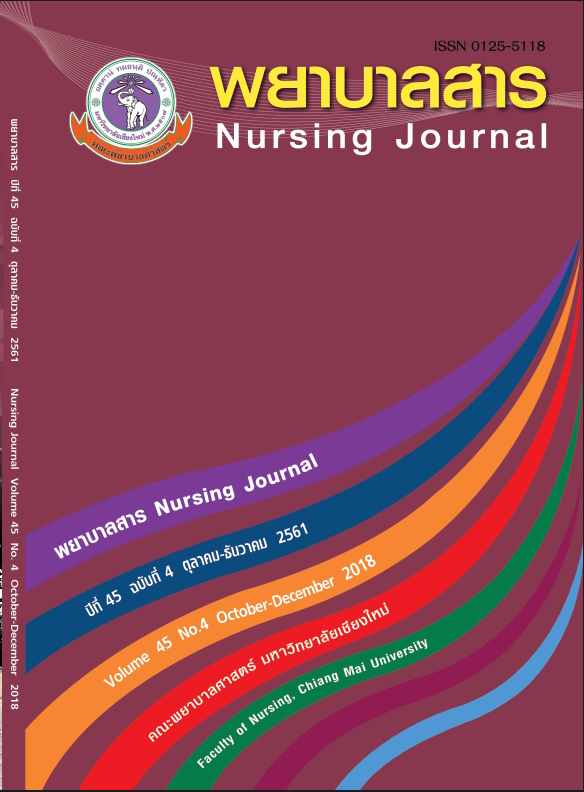ปัจจัยทำนายพฤติกรรมการดูแลของผู้ดูแลเพื่อการป้องกันการติดเชื้อทางเดินหายใจ ในเด็กโรคหัวใจพิการแต่กำเนิด
คำสำคัญ:
พฤติกรรมการดูแลการป้องกันการติดเชื้อทางเดินหายใจ, เด็กโรคหัวใจพิการแต่กำเนิด, ปัจจัยทำนายบทคัดย่อ
พฤติกรรมการดูแลของผู้ดูแลเพื่อการป้องกันการติดเชื้อทางเดินหายใจในเด็กโรคหัวใจพิการแต่กำเนิดที่ถูกต้อง จะช่วยลดการเกิดภาวะแทรกซ้อนในเด็กโรคหัวใจพิการแต่กำเนิด และได้รับการผ่าตัดรักษาตามแผน การวิจัยนี้เป็นการหาความสัมพันธ์เชิงทำนาย มีวัตถุประสงค์เพื่อ 1) ศึกษาพฤติกรรมการดูแลของผู้ดูแลเพื่อการป้องกันการติดเชื้อทางเดินหายใจในเด็กโรคหัวใจพิการแต่กำเนิด และ 2) ศึกษาอำนาจการทำนายของความรู้ การรับรู้ความรุนแรงของโรค การรับรู้อุปสรรค และการรับรู้สมรรถนะแห่งตน ต่อพฤติกรรมการดูแลของผู้ดูแลเพื่อการป้องกันการติดเชื้อทางเดินหายใจในเด็กโรคหัวใจพิการแต่กำเนิด กลุ่มตัวอย่าง คือ ผู้ดูแลของเด็กโรคหัวใจพิการแต่กำเนิดที่มีอายุตั้งแต่ 1 เดือนถึง 5 ปี จำนวน 135 ราย ที่ได้รับการวินิจฉัยจากแพทย์ว่าเป็นโรคหัวใจพิการแต่กำเนิดชนิดที่มีเลือดไปปอดมาก และยังไม่ได้รับการรักษาด้วยการผ่าตัดที่มาติดตามการรักษาที่แผนกผู้ป่วยนอก ศูนย์หัวใจและโรงพยาบาลมหาวิทยาลัยในภาคตะวันออกเฉียงเหนือ ตั้งแต่เดือนมกราคม ถึงเดือนมีนาคม 2559 เครื่องมือที่ใช้ในการวิจัย ประกอบด้วย 1) แบบสอบถามพฤติกรรมการดูแลของผู้ดูแลเพื่อการป้องกันการติดเชื้อทางเดินหายใจในเด็กโรคหัวใจพิการแต่กำเนิด 2) แบบประเมินความรู้ และ 3) แบบสอบถามการรับรู้สมรรถนะแห่งตนเกี่ยวกับพฤติกรรมการดูแลของผู้ดูแลเพื่อการป้องกันการติดเชื้อทางเดินหายใจในเด็กโรคหัวใจพิการ แต่กำเนิดที่ผู้วิจัยนำมาจากแบบสอบถามของศุภมาส สร้อยเพชร และอุษณีย์ จินตะเวช (2557) 4) แบบสอบถามการรับรู้ความรุนแรงของโรค และ 5) แบบสอบถามการรับรู้อุปสรรคเกี่ยวกับพฤติกรรมการดูแลของผู้ดูแลเพื่อการป้องกันการติดเชื้อทางเดินหายใจในเด็กโรคหัวใจพิการแต่กำเนิด ที่ผู้วิจัยสร้างขึ้นจากการทบทวนวรรณกรรม มีค่าดัชนีความตรงเนื้อหาเท่ากับ .85 และ .81 ตามลำดับ เครื่องมือทั้งหมดมีค่าความเชื่อมั่นเท่ากับ .92 .83 .82 .81 และ .96 ตามลำดับ วิเคราะห์ข้อมูลโดยใช้สถิติพรรณนา และสถิติการวิเคราะห์ถดถอยพหุคูณแบบขั้นตอน
ผลการศึกษาพบว่า
- ผู้ดูแลมีพฤติกรรมการดูแลเพื่อการป้องกันการติดเชื้อทางเดินหายใจในเด็กโรคหัวใจพิการแต่กำเนิดอยู่ในระดับมาก (`X = 81.23, SD = 8.81)
- ความรู้ การรับรู้ความรุนแรงของโรค และการรับรู้สมรรถนะแห่งตน สามารถร่วมกันทำนายพฤติกรรมการดูแลของผู้ดูแลเพื่อการป้องกันการติดเชื้อทางเดินหายใจในเด็กโรคหัวใจพิการแต่กำเนิดได้ร้อยละ 17.90 อย่างมีนัยสำคัญทางสถิติที่ .05 โดยพบว่าการรับรู้สมรรถนะแห่งตนสามารถทำนายพฤติกรรมการดูแลของผู้ดูแลเพื่อการป้องกันการติดเชื้อทางเดินหายใจในเด็กโรคหัวใจพิการแต่กำเนิดได้ดีที่สุด (b=.234, p< .05) รองลงมาคือ ความรู้ และการรับรู้ความรุนแรงของโรค (b=.196, p< .05; b =.185, p< .05) ตามลำดับ
ผลการศึกษาครั้งนี้ทำให้ได้ข้อมูลเกี่ยวกับพฤติกรรมการดูแลของผู้ดูแลเพื่อการป้องกันการติดเชื้อทางเดินหายใจในเด็กโรคหัวใจพิการแต่กำเนิด และเป็นแนวทางในการสร้างโปรแกรมส่งเสริมการรับรู้สมรรถนะแห่งตน ความรู้ และการรับรู้ความรุนแรงของโรคของผู้ดูแล
References
Asumpinzub, U. (1997). The Relationship between Perception of Disease, Selected Factors and
Maternal Behaviors in Caring for Children with Congenital Heart Disease. Thesis Master of Nursing Science (Materal and Child Nursing), Graduate School, Mahidol University. (In Thai)
Bandura, A. (1997). Self-efficacy: The exercise of control. New York: W.H. Freeman and
company.
Becker, M. H. (1974). The Health Belief Model and Sick Role Behavior. Health Education &
Behavior, 2(4), 409-419.
Carey, L. K., Nicholson, B. C., & Fox, R. A. (2002). Maternal factors related to parenting young
children with congenital heart disease. Journal of Pediatric Nursing, 17(3), 174-183.
Chaisom, P., Yenbut, J., Chontawan, R., Soivong, P., & Patumanond, J. (2010). Predicting factors of dependent care behaviors among mothers of toddlers with congenital heart disease. Chiang Mai University Journal of Natural Sciences, 9(2), 193-200.
Champion, V. L., Skinner C. S., (2008). The health belief model. In K. Glanz, B. K. Rimer, K. Viswanath (Eds.), Health behavior and health education: Theory, research, and practice (4th ed). San Francisco: Jossey-Bass. 45-65.
Cheuk, D. K. L., Wong, S. M. Y., Choi, Y. P., Chau, A. K. T., & Cheung, Y. F. (2004). Parents’ understanding of their child’s congenital heart disease. Heart, 90(4), 435-439.
Go, A. S., Mozaffarian, D., Roger, V. L., Benjamin, E. J., Berry, J. D., Borden, W. B., ... & Turner, M. B. American Heart Association Statistics C, Stroke Statistics S (2013) Heart disease and stroke statistics–2013 update: a report from the American Heart Association. Circulation, 127(1), e6-e245.
Haag, F., Casonato, S., Varela, F., & Firpo, C. (2011). Parents' knowledge of infective endocarditis in children with congenital heart disease. Brazilian Journal of Cardiovascular Surgery, 26(3), 413-418.
Healy, F., Hanna, B. D., & Zinman, R. (2012). Pulmonary complications of congenital heart disease. Paediatric Respiratory Reviews, 13(1), 10-15.
Imthongbai, L. (2000). Factors Effecting on Mother’ s Asthma Preventive Recurrent Behaviors in Children 1-5 Years of Age at the Government Hospitals in Bangkok Metropolis. Thesis Master of Science (Health Education), Graduate School, Kasetsart University. (In Thai)
Jaide, C. Santati, S. & Kongsaktrakul, C. (2012). Factors Related to Child Care Workers’ Behavior in Prevention of Acute Respiratory Infection in Child Care Centers. Ramathibodi Nursing Journal, 18(3), 389-403. (In Thai)
Keawvichit, N. & Thajeen, K. (2007). Knowledge and the parental role in caring for children with heart disease. Songklanagarind Medical Journal, 25(4), 273-282. (In Thai)
Kocis, K. C., & Meliones, J. N. (2000). Cardiopulmonary interactions in children with congenital heart disease: Physiology and clinical correlates. Progress in Pediatric Cardiology, 11(3), 203-210.
Lee, L., Tin, S., & Kelley, S. T. (2007). Culture-independent analysis of bacterial diversity In a child-care facility. Biomed Central Microbiology Journal, 7(1), 1-13.
Leitch, C. A. (2000). Growth, nutrition and energy expenditure in pediatric heart failure. Progress in Pediatric Cardiology, 11(3), 195-202.
Marlow, D. R., & Redding, B. A. (1988). Pediatric nursing ( 6th ed.). Philadelphia: W.B. Saunders. 18-26.
Orem, D.E. (1995). Nursing: Concepts of practice (5th ed.). St. Louis : Mosby Year Book .
Orem, D. E. (2001). Nursing: Concepts of practice (6th ed.). St. Louis: Mosby Year Book.
Pender, N.J. (1987). Health promotion in Nursing Paractice. 2nd ed. Stamford, CT : Appleton &
Lange.
Park, M. K. (2008). Pediatric cardiology for practitioners (5th ed.). United States of America: Elsevier Health Sciences.
Polit, D. F. (2010). Statistics and Data Analysis for Nursing Research (2nded.). United States of America: Pearson Education.
Phromreungrit, K. (2015). Caregiving and Related Factors among Caregivers of Children with
Congenital Heart Disease. Nursing Journal, 42(Supplement), 35-45. (In Thai)
Sittiwangkul, R. (2013). Critical congenital heart diseases in infants. In Charoenkwan, P. Silvilairat, S. Natesirinilkul, R. Louthrenoo, O. & Opastirakul, S. (Editor), Padiatric Emergencies (1sted.). Chiang Mai : Central Printing Company Limited. 90-96. (In Thai)
Soiphet, S. (2014). Care Behaviors of the Parental and Related Factors to Preventing Respiratory
Tract Infection in Children with Congenital Heart Disease. Thesis Master of Nursing Science (Pediatric Nursing), Graduate School, Chiang Mai University. (In Thai)
Thoits, P. A. (1982). Conceptual, methodological, and theoretical problems in studying social
support as a buffer against life stress. Journal of Health and Social behavior, 145-159.
Wilson, D. (2009). Health promotion of the toddler and family. In M. J. Hockenberry, &
D. Wilson (Eds.), Wong’s essentials pediatric nursing (8thed). St. Louis: Mosby.
Woodward, C. S. (2011). Keeping children with congenital heart disease healthy. Journal of Pediatric Health Care, 25(6), 373-378.
Downloads
เผยแพร่แล้ว
How to Cite
ฉบับ
บท
License
บทความที่ได้รับการตีพิมพ์เป็นลิขสิทธิ์ของวารสารพยาบาลสาร
ข้อความที่ปรากฏในบทความแต่ละเรื่องในวารสารวิชาการเล่มนี้เป็นความคิดเห็นส่วนตัวของผู้เขียนแต่ละท่านไม่เกี่ยวข้องกับมหาวิทยาลัยเชียงใหม่ และคณาจารย์ท่านอื่นๆในมหาวิทยาลัยฯ แต่อย่างใด ความรับผิดชอบองค์ประกอบทั้งหมดของบทความแต่ละเรื่องเป็นของผู้เขียนแต่ละท่าน หากมีความผิดพลาดใด ๆ ผู้เขียนแต่ละท่านจะรับผิดชอบบทความของตนเองแต่ผู้เดียว





